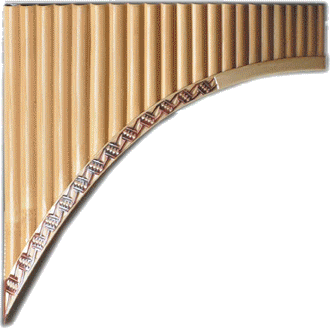Chromatic
If you want to be free to play any type of music, you need a chromatic instrument. That means, an instrument that provides you with all 12 notes of the chromatic scale. If only it were that simple! For you also need to ask, are they all easy to find or perform?
Various solutions have been proposed for chromatic panpipes, some involving 12 tubes per octave, arranged in one or two rows, and even a 14-tube model with the scales of C and C-sharp on two rows. You can see them in various youTube videos. They all look pretty ponderous to play, lacking in manoeuverability.
None of that is really necessary, as a simple note-bending technique which you can learn in a day, involving tipping the instrument, lets you get two notes a semitone apart out of a single tube. That means that on a diatonic panpipe tuned in G major you can find any other scale by knowing which notes to bend. It is, needless to say, quite a complicated task, like playing the piano blindfolded.
So I got to wondering, can we go one better than today's professional panpipe, based on the traditional Romanian panpipe, the nai. And the answer is, yes, we can go not just one, but three or four better! It wasn't just the note layout that I found impractical. Take a good look - inside and outside:

- Question 1: if you can get two notes from each tube and there are twelve notes per octave, why do you need 7 tubes per octave? Why make one scale easier and all the others harder?
- Question 2: if you need to tip the instrument fast to get the semitones, why is all the weight at the bottom, with all the corks and wax, and the "shoe" (the wooden reinforcement at the bottom)? That increases the work needed.
- Question 3: the pivot for tipping the instrument is determined by the vertical length at the short end, supported by the upper hand, so why is so much extra length added? It adds unnecessary back and forth travel to the blowing end, impacting (literally) the embouchure and possibly loosening the lower teeth!
- Question 4: the photo shows the unnecessary extra length at the treble end. Obviously if you are using bamboo, that extra length is needed to provide a larger glueing surface (a stronger join) for the short pipes ... so why use bamboo at all if it can be made all in one piece in plastic?? (And for a twentieth of the price, once we go into production - watch this space!)
The answer to the last three questions is clear. A simple diswasher-safe plastic model with no unnecessary added length or weight. Plastic also permits other design optimisations such as perfectly graded tube diameters for a homogeneous sound and a paraboloidal bore profile (rather than a simple cylinder) for in-tune harmonics/overblow and added response and sound projection.
And the answer to Question 1 (and indeed to a whole lot of other performance-related questions - see below), is whole tone tuning: six tubes per octave, the minimum required for chromatic playing. Every tube is separated from its neighbour by one whole tone, so there are no surprises when you are playing by ear.

Advantages of whole tone tuning
- Only two scale shapes to be learned for each scale type.
- Transposition becomes a no-brainer. Read trumpet parts, accompany singers.
- To play a tune by ear you don't need to decide in advance which key you are in - once you find the first note the rest follows. Like singing in the shower.
- The same move will always give the same interval, giving positive feedback to learner and performer alike.
- All synthetic scales and modes of limited transposition become a piece of cake
- Builds your interval awareness and makes interval structure transparent
- Six tubes per octave instead of seven makes 9% less weight
- Six tubes per octave also means less distance to cover large intervals. Less effort, but more importantly, less mistakes!
- All major scales can be played legato, unlike on a diatonic panflute where the sharp keys require tubes to be skipped.
- You get to practice open and "bent" notes in equal measure, ensuring balanced development of your technique.
Disadvantages of whole tone tuning
- Might seem foreign at first!
- Takes longer to master sight-reading (though sight-transposing is easier)
- It's addictive. You won't want to go back to playing diatonic!
Follow me on Twitter @jazzpanflute














